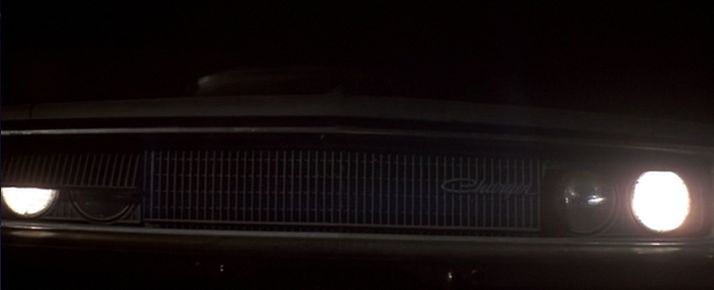 Back to selection
Back to selection
The Blue Velvet Project
Blue Velvet, 47 seconds at a time by Nicholas Rombes
The Blue Velvet Project, #92

Second #4324, 72:04
Frank’s 1968 Dodge Charger with pop-up headlamps, stretching the screen horizontally as far as it will go. There are three in the front of the car, and three in the back including Jeffrey, who is riding bitch. They are tearing through the night, towards Ben’s, where, in an act of dark magic, Frank will literally disappear from the screen. But before that, there’s the journey that begins with a cut that takes us from the hallway of Dorothy’s apartment to the frame above, at second #4324. The shot breakdown over the next roughly 30 seconds proceeds like this:
* shot of Charger grill and headlamps / 3 seconds
* Charger tearing down empty main street / 4 seconds
* close-up of Jeffrey, in back seat / 2 seconds
* Jeffrey’s pov, looking outside car / 2 seconds
* close-up of Jeffrey / 3 seconds
* medium shot of characters in front seat / 2 seconds
* medium shot of characters in back seat / 3 seconds
* close-up of Frank / 2 seconds
Sergei Eisenstein, from his 1929 essay “The Filmic Fourth Dimension,” commented on how the combination of filmic sound and image creates something that transcends both sound and image (italics are Eisenstein’s):
And yet we cannot reduce aural and visual perceptions to a common denominator. They are values of different dimensions. But the visual overtone and the sound overtone are values of a singly measured substance. Because, if the frame is a visual perception, and the tone is an aural perception, visual as well as aural overtones are a totally physiological sensation. And, consequently, they are of one and the same kind, outside the sound or aural categories that serve as guides, conductors to its achievements.
For the musical overtone (a throb) it is not strictly fitting to say: ‘I hear.’
Nor for the visual overtone: ‘I see.’
For both, a new uniform formula must enter our vocabulary: ‘I feel.’
The carefully modulated shot sequence in the Charger—each one lasting approximately 2-3 seconds—creates a sense of well-ordered dread that’s fueled by the underlying roar of the car, as if they all are riding the Devil’s back. They are, as Jeffrey realizes too late, going straight to hell. Which is to say: they are going to Ben’s place.
Over the period of one full year — three days per week — The Blue Velvet Project will seize a frame every 47 seconds of David Lynch’s classic to explore. These posts will run until second 7,200 in August 2012. For a complete archive of the project, click here. And here is the introduction to the project.
